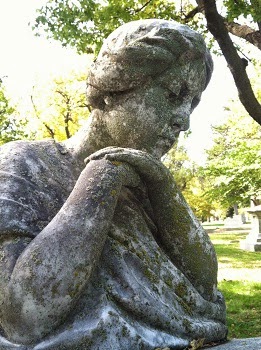Halloween seems to be a time when folks develop a somewhat macabre interest in cemeteries and tombstones, but my interest in these things isn't seasonal, and it isn't really macabre. I've sought out pioneer cemeteries and the stories hidden behind the epitaphs since I was a girl tromping about with my family.
When I was working on A Captain for Laura Rose (http://tinyurl.com/n2ykr2f) I spent some time exploring a St. Louis cemetery, led there by mention of steamboat pilot, Isaiah Sellers (Mark Twain knew him!)
This past year I even developed a program to give on these "Stories in Stone." Who wouldn't admire the artistry present in the stonework, zinc, and bronze forms used in memorials across the centuries. I'm also moved by the epitaphs (I tend to collect them).
In 1904, this epitaph was cast into a bronze plaque mounted on a granite boulder:
Warm summer sun, shine kindly here,
Warm southern wind, blow softly here,
Green sod above, lie light, lie light,
Good night, dear heart,
Good night, Good night.
Dear companion remember me,
As I am now, so you must be
Prepare for death and follow me.
This one from 1895 made me wonder about the life it sums up in a rather acerbic manner:
She hath done what she could.
We don't often associate a sense of humor with epitaphs, but in Kentucky a woman's epitaph gives an order: "Do not stand at my grave and cry. I am not here. I did not die." Her husband's epitaph asks a question: "If we didn't die, what are we doing here?" I imagine these two were the life of every party they attended!
One of my favorites is short and simple, but there is a world of story in the message:
Born to die, August 4, 1840
Died to live May 30 1878
This reminds me of the epitaph I'll have put on my tombstone one day. It's part of a lovely poem written by Calvin Miller:
Graves are only doorways cut in sod,
And dying is but getting dressed for God.
Are you like me? Do you enjoy wandering old cemeteries and wondering about the stories represented by the grave markers? What's your favorite or most memorable discovery?
____________________________
PS: If you'd like a copy of a 1912 story originally told by a homesteader from Oregon Trail days, go to www.stephaniewhitson.com and subscribe to my newsletter. Everyone on my mailing list will received the story in a special mailing sent out the first week of November.










